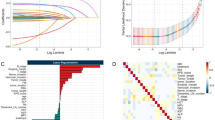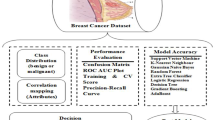Abstract
The diagnosis of the degree of differentiation of tumor cells can help physicians to make timely detection and take appropriate treatment for the patient’s condition. The original datasets are clustered into two independent types by the Kohonen clustering algorithm. One type is used as the development sets to find correlation indicators and establish predictive models, while the other type is used as the validation sets to test the correlation indicators and model. Thirteen indicators significantly associated with the degree of differentiation of esophageal squamous cell carcinoma are found by Kohonen algorithm in the development sets. Ten different machine learning classification algorithms are used to predict the differentiation of esophageal squamous cell carcinoma. The artificial bee colony-support vector machine (ABC-SVM) has better prediction accuracy than the other nine algorithms and has a shorter training time. The average accuracy of the 10-fold cross-validation reached 81.5\(\%\) by ABC-SVM algorithm. In the development sets, a model with the great merit for the degree of differentiation is found based on logistic regression algorithm. The AUC value of the model is 0.672 and 0.753 in the development sets and validation sets, respectively. \(p-values\) are less than 0.05. The results are shown that the model has a high predictive value for the differentiation of esophageal squamous cell carcinoma.
This work was supported in part by the National Key Research and Development Program of China for International S and T Cooperation Projects under Grant 2017YFE0103900, in part by the Joint Funds of the National Natural Science Foundation of China under Grant U1804262, in part by the State Key Program of National Natural Science of China under Grant 61632002, in part by the Foundation of Young Key Teachers from University of Henan Province under Grant 2018GGJS092, in part by the Youth Talent Lifting Project of Henan Province under Grant 2018HYTP016, in part by the Henan Province University Science and Technology Innovation Talent Support Plan under Grant 20HASTIT027, in part by the Zhongyuan Thousand Talents Program under Grant 204200510003, and in part by the Open Fund of State Key Laboratory of Esophageal Cancer Prevention and Treatment under Grant K2020-0010 and Grant K2020-0011.
Access this chapter
Tax calculation will be finalised at checkout
Purchases are for personal use only
Similar content being viewed by others
References
Ebigbo, A.: A technical review of artificial intelligence as applied to gastrointestinal endoscopy: clarifying the terminology. Endos. Int. Open 7(12), E1616–E1623 (2019)
Murakami, Y., Nagata, Y., Kawahara, D.: A prediction model for pathological findings after neoadjuvant chemoradiotherapy for resectable locally advanced esophageal cancer based on PET images using radiomics and machine-learning. J. Clin. Oncol. 38, 456–456 (2020)
Menya, D., Kigen, N., Oduor, M.: Traditional and commercial alcohols and esophageal cancer risk in Kenya. Int. J. Cancer 144(3), 459–469 (2019)
Gillies, C., Farrukh, A., Abrams, R.: Risk of esophageal cancer in achalasia cardia. A Meta-analysis. 3(3), 196–200 (2019)
Haisley, K.R., et al.: Specific tumor characteristics predict upstaging in early-stage esophageal cancer. Ann. Surg. Oncol. 26(2), 514–522 (2018). https://doi.org/10.1245/s10434-018-6804-z
Sun, J., Han, G., Zeng, Z., Wang, Y.: Memristor-based neural network circuit of full-function Pavlov associative memory with time delay and variable learning rate. IEEE Trans. Cybern. 50(7), 2935–2945 (2020)
Sun, J., Yang, Y., Wang, Y., Wang, L., Song, X., Zhao, X.: Survival risk prediction of esophageal cancer based on self-organizing maps clustering and support vector machine ensembles. IEEE Access 8, 131449–131460 (2020)
Sun, J., Zhao, X., Fang, J., Wang, Y.: Autonomous memristor chaotic systems of infinite chaotic attractors and circuitry realization. Nonlinear Dyn. 94(4), 2879–2887 (2018). https://doi.org/10.1007/s11071-018-4531-4
Wang, Y., Li, Z., Sun, J.: Three-variable chaotic oscillatory system based on DNA strand displacement and its coupling combination synchronization. IEEE Trans. Nanobioscience 19(3), 434–445 (2020)
Hou, K., et al.: Research on practical power system stability analysis algorithm based on modified SVM. Protect. Control Modern Power Syst. 3(1), 1–7 (2018). https://doi.org/10.1186/s41601-018-0086-0
El-Saadawi, M., Hatata, A.: A novel protection scheme for synchronous generator stator windings based on SVM. Protect. Control Modern Power Syst. 2(1), 1–12 (2017). https://doi.org/10.1186/s41601-017-0057-x
Mahmoodabadi, M.: Epidemic model analyzed via particle swarm optimization based homotopy perturbation method. Inf. Med. Unlocked 18, 100293 (2020)
Alshamlan, H.M., Badr, G.H., Alohali, Y.A.: ABC-SVM: artificial bee colony and SVM method for microarray gene selection and multi class cancer classification. Int. J. Mach. Learn. Comput. 6(3), 184 (2016)
Grover, P., Chawla, S.: Text feature space optimization using artificial bee colony. In: Das, K.N., Bansal, J.C., Deep, K., Nagar, A.K., Pathipooranam, P., Naidu, R.C. (eds.) Soft Computing for Problem Solving. AISC, vol. 1057, pp. 691–703. Springer, Singapore (2020). https://doi.org/10.1007/978-981-15-0184-5_59
Andrushia, A.D., Patricia, A.T.: Artificial bee colony optimization (ABC) for grape leaves disease detection. Evol. Syst. 11(1), 105–117 (2019). https://doi.org/10.1007/s12530-019-09289-2
Watada, J., Roy, A., Wang, B., Tan, S.C., Xu, B.: An artificial bee colony based double layered neural network approach for solving quadratic bi-level programming problems. IEEE Access 8, 21549–21564 (2020)
Christodoulou, E., Ma, J., Collins, G.S., Steyerberg, E.W., Verbakel, J.Y., Van Calster, B.: A systematic review shows no performance benefit of machine learning over logistic regression for clinical prediction models. J. Clin. Epidemiol. 110, 12–22 (2019)
Wen, P., Chen, S., Wang, J., Che, W.: Receiver operating characteristics (ROC) analysis for decreased disease risk and elevated treatment response to pegylated-interferon in chronic hepatitis b patients. Futur. Gener. Comput. Syst. 98, 372–376 (2019)
Tada, T., et al.: Impact of albumin-bilirubin grade on survival in patients with hepatocellular carcinoma who received sorafenib: an analysis using time-dependent receiver operating characteristic. J. Gastroenterol. Hepatol. 34(6), 1066–1073 (2019)
Evcimen, Y., Onur, I.U., Cengiz, H., Yigit, F.U.: Optical coherence tomography findings in pre-eclampsia: a preliminary receiver operating characteristic analysis on choroidal thickness for disease severity. Curr. Eye Res. 44(8), 916–920 (2019)
Jang, E.J., Nandram, B., Ko, Y., Kim, D.H.: Small area estimation of receiver operating characteristic curves for ordinal data under stochastic ordering. Stat. Med. 1–15 (2020)
Author information
Authors and Affiliations
Corresponding author
Editor information
Editors and Affiliations
Rights and permissions
Copyright information
© 2021 Springer Nature Singapore Pte Ltd.
About this paper
Cite this paper
Yang, Y., Ji, H., Sun, J., Wang, Y. (2021). The Predictive Model of Esophageal Squamous Cell Carcinoma Differentiation. In: Pan, L., Pang, S., Song, T., Gong, F. (eds) Bio-Inspired Computing: Theories and Applications. BIC-TA 2020. Communications in Computer and Information Science, vol 1363. Springer, Singapore. https://doi.org/10.1007/978-981-16-1354-8_22
Download citation
DOI: https://doi.org/10.1007/978-981-16-1354-8_22
Published:
Publisher Name: Springer, Singapore
Print ISBN: 978-981-16-1353-1
Online ISBN: 978-981-16-1354-8
eBook Packages: Computer ScienceComputer Science (R0)




